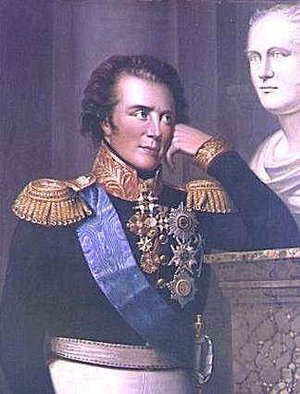Gustaf Mauritz Armfelt
|
|
Count Gustaf Mauritz Armfelt (March 31, 1757 – August 19, 1814) was a Swedish courtier and diplomat. Born in Finland, he was the great grandson of Charles XII of Sweden's general, Carl Gustaf Armfelt. His advice to Russia's Tsar Alexander I was of utmost importance for the establishment of the Grand Duchy of Finland prepared to become increasingly autonomous.
| Contents |
Career
In 1774 he became an ensign in the guards, but his frivolity provoked the displeasure of Gustav III of Sweden and he thought it prudent to go abroad. Subsequently however, in 1780 he met the king again at Spa and completely won the monarch's favour by his natural amiability, intelligence and intelligent social gifts. Henceforth his fortune was made. At first as the maitre des plaisirs of the Swedish court, but it was not long before more serious affairs were entrusted to him. He took the part in the negotiations with Catherine II of Russia in 1783 and during the Russian War of 1788–1790 he was one of the king's most trusted and active counsellors. He also displayed great valour in the field. In 1788, when the Danes unexpectedly invaded Sweden and threatened Gothenburg, under the king's directions Armfelt organized the Dalecarlian levies and led them to victory. He remained absolutely faithful to king Gustav when nearly the whole of the nobility fell away from him; brilliantly distinguished himself in the later phases of the Russian war; and was the Swedish plenipotentiary at the conclusion of the Treaty of Värälä. During the years of Gustav III, his influence was paramount, though Armfelt protested against his master's headstrong championship of his subjects.
Diplomacy
On his deathbed Gustav III, 1792, committed the care of his infant son to Armfelt and appointed him a member the council of regency and as the Over-Governor of Stockholm, but the anti-Gustavian duke-regent Charles sent Armfelt as Swedish ambassador to Naples to get rid him. From Naples Armfelt communicated with Catherine II, arguing her to bring about by means of a military demonstration a change in the Swedish government in favour of the Gustavians. The plot was discovered by the regent's spies, and Armfelt only escaped from the man-of-war sent to Naples to seize him, with the assistance of Queen Caroline. He now fled to Russia, where he was interned at Kaluga, while at home he was condemned to confiscation and death as a traitor, and his unjustly accused mistress Magdalena Rudenschöld was publicly whipped to gratify old grudge of the regent's, and imprisoned for two years in Stockholm.
Military service
When Gustav IV of Sweden attained his majority, Armfelt was completely rehabilitated and sent as Swedish ambassador to Vienna in 1802, but was obliged to quit at post two years later for sharply attacking the Austrian government's attitude towards Bonaparte. From 1805 to 1807 he was commander-in-chief of the Swedish forces in Pomerania, where he displayed great ability and retarded the conquest of the duchy as long as it was humanly possible. On his return home, was appointed commander-in-chief on the Norwegian frontier, where he could do nothing owing to the ordres, contre-ordres et désordres of his lunatic master.
In Russian service
He would have nothing to say to the revolutionaries who in 1809 deposed Gustav IV and his whole family. Armfelt was the most courageous of the deposed king's supporters and was resolved to retire to Finland that was ceded to Russia. But again appointed to high offices for the Swedish government, his departure was delayed until his enemies gathered and gained a decree expelling Armfelt as a conspirator in 1811. On March 31 he visited Russia's ambassador to Stockholm and delivered his oath of allegiance, and was the following day deported from Sweden.
Over the impressionable Alexander I of Russia, Armfelt exercised almost as large an influence as Czartoryski. He contributed more than any one else to the erection of the Grand Duchy of Finland into an autonomous state, and gained Alexander over to the plan of uniting Norway with Sweden.
Armfelt, who had been Chancellor of the Royal Academy of Turku 1791–92 was again made Chancellor of the now Imperial Academy of Turku 1812–14. Nobilitated by the Emperor, he was also briefly Governor-General of Finland in 1813.
He died at Tsarskoe Selo by Saint Petersburg on August 19, 1814.
View of Armfelt
Together with Göran Magnus Sprengtporten, Armfelt can be regarded as one of the fathers of Finland as a separate nation. Because of Armfelt's unpopularity with several of the nobles in Sweden, and not to mention the fact that Armfelt "turned Russian", he is a rather mysterious and generally unknown character in Swedish history. When Armfelt left Sweden to return to his native Finland (which now was in Russian hands), he entered into the service of Tsar Alexander I of Russia to help Finland with its transition from Swedish to Russian rule.
This view of Armfelt would persist for well over a century in Sweden and it was not until recently that the view of Armfelt in Sweden changed for the better. In Finland, he has been regarded highly as a Finnish patriot and a great statesman.
Because he chose to remain loyal to Finland and its people rather than its former ruler Sweden, which was still in severe shock about losing its 600 year old provinces to its arch-enemy Russia, he was labeled as a traitor to the Swedish Crown and sentenced to death for treason. The sentence had no meaning outside of Sweden, however, as Sweden's attempts to recapture Finland never truly materialised but remained simply wishful thinking used by politicians to gain favour with both the people and nobles.
See also
Georg Magnus Sprengtportenfi:Gustaf Mauritz Armfelt sv:Gustaf Mauritz Armfelt

